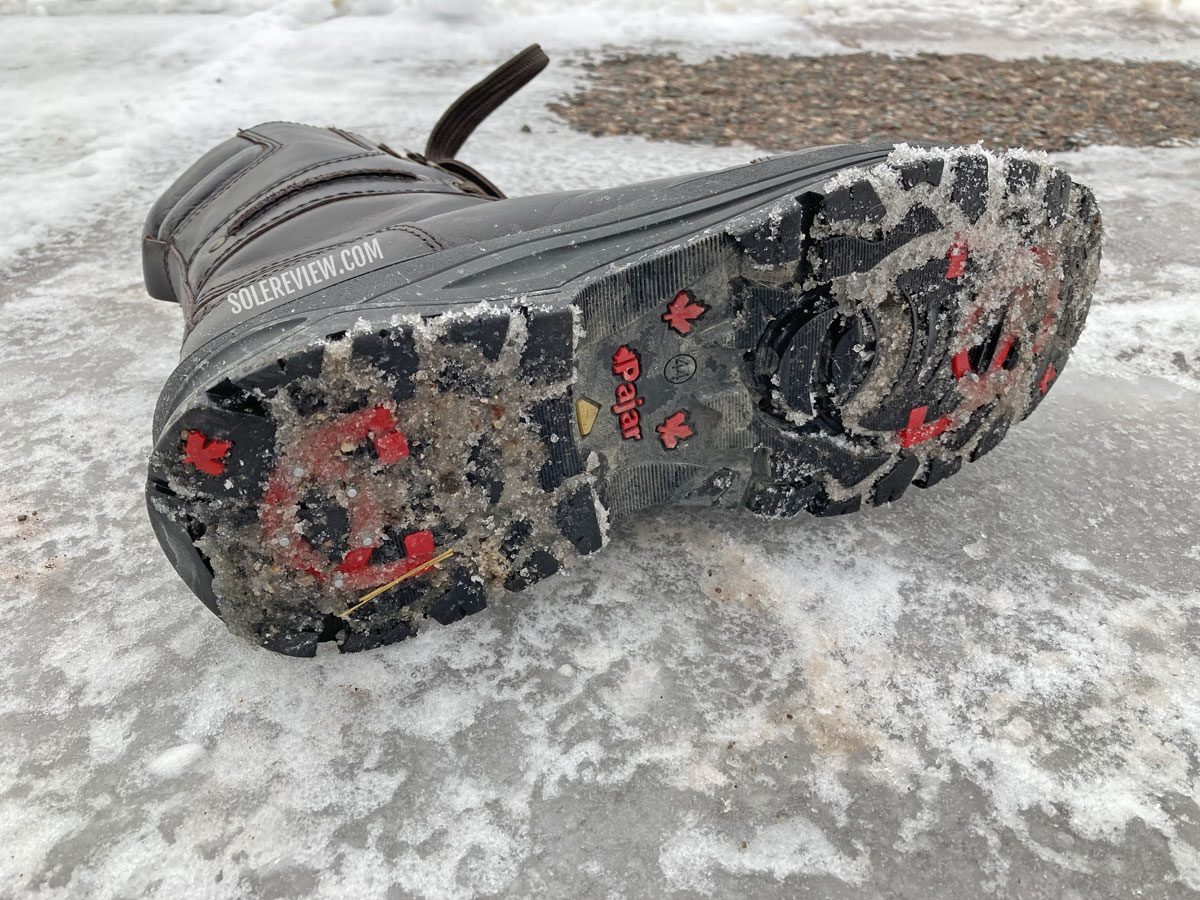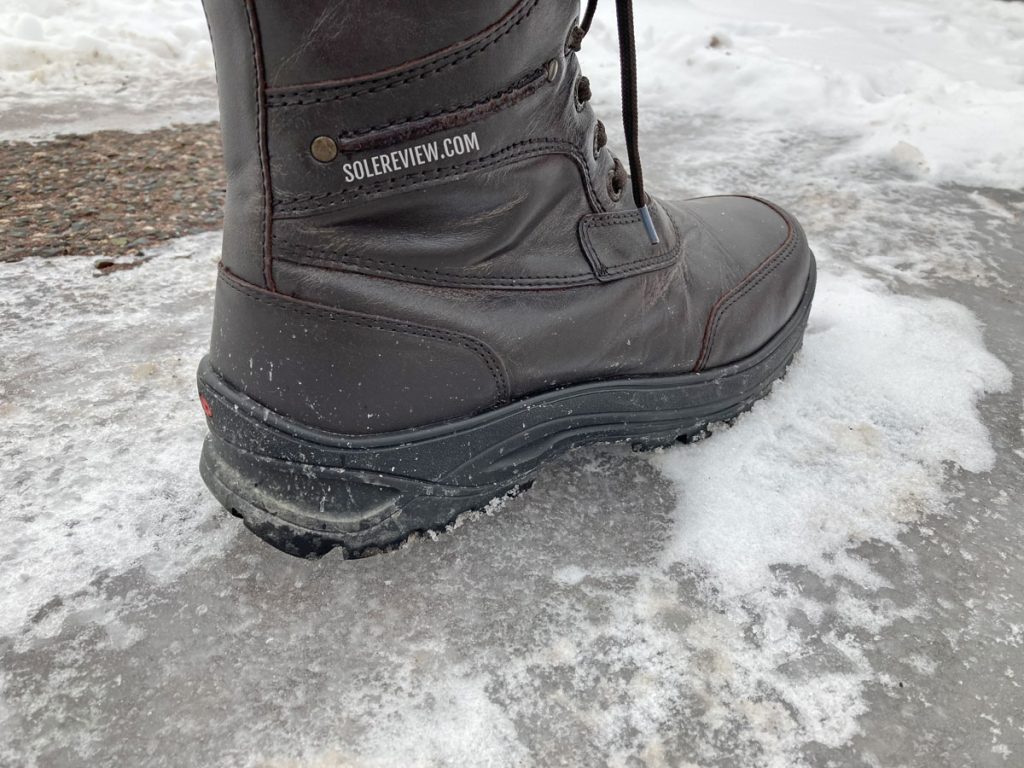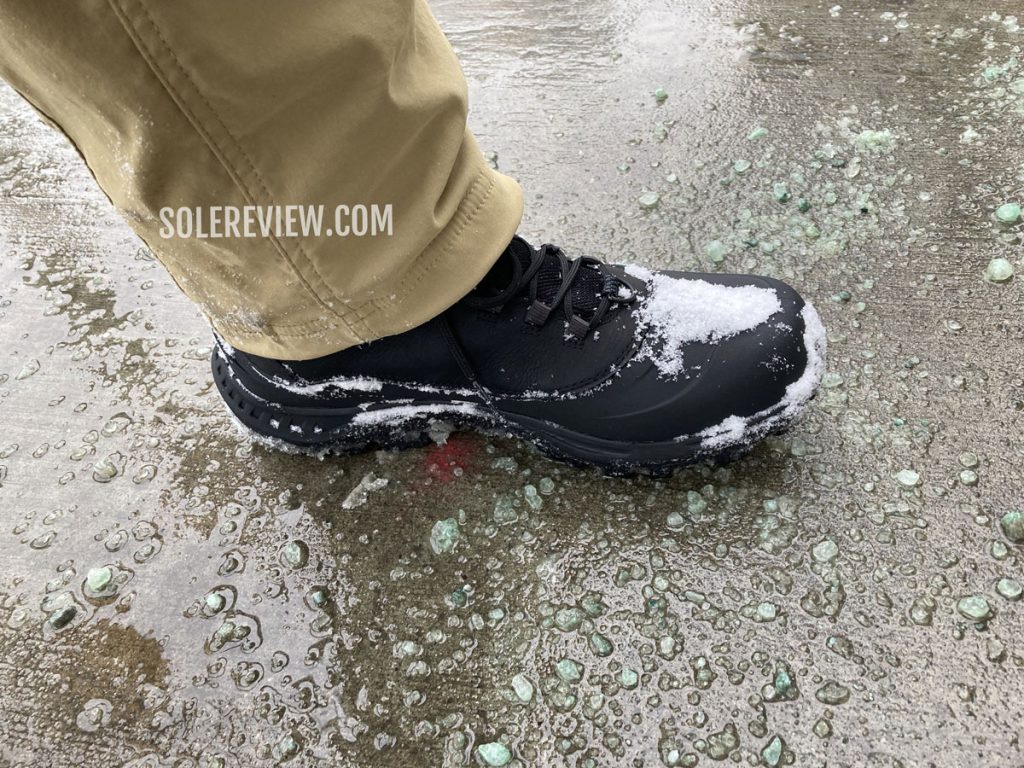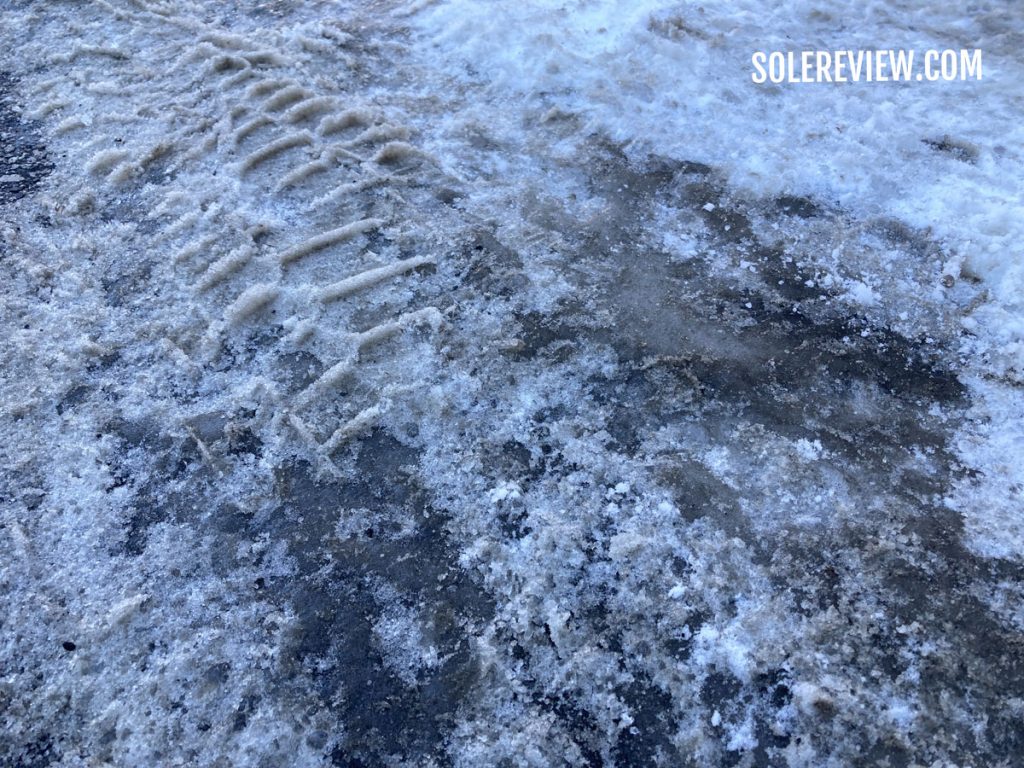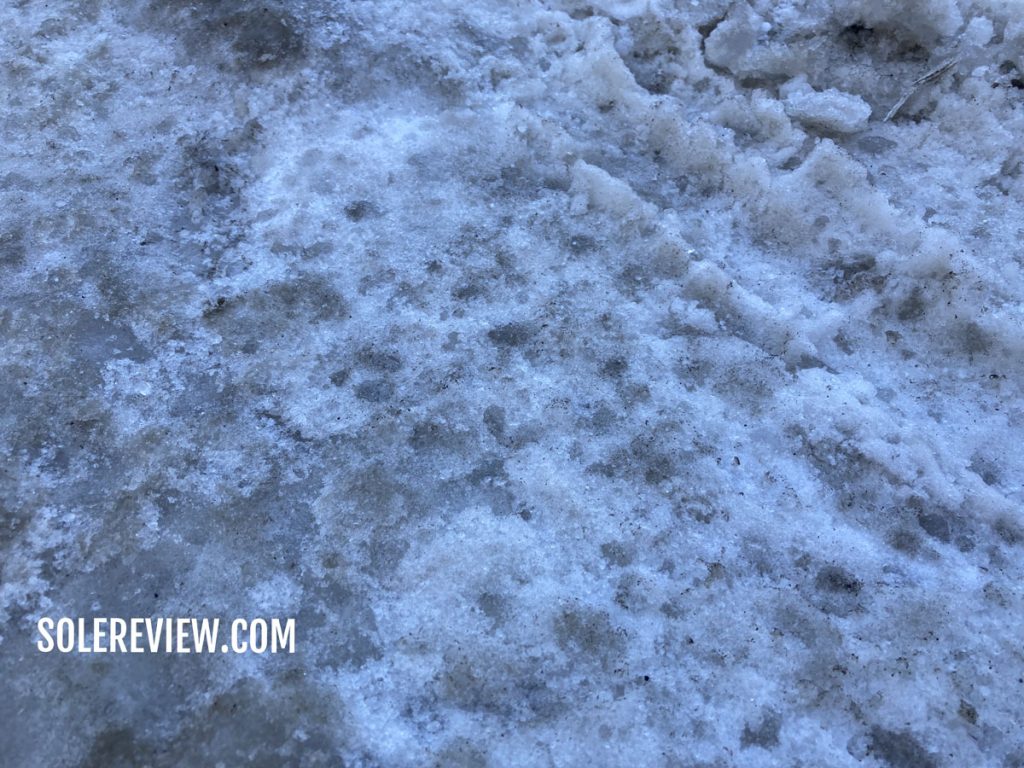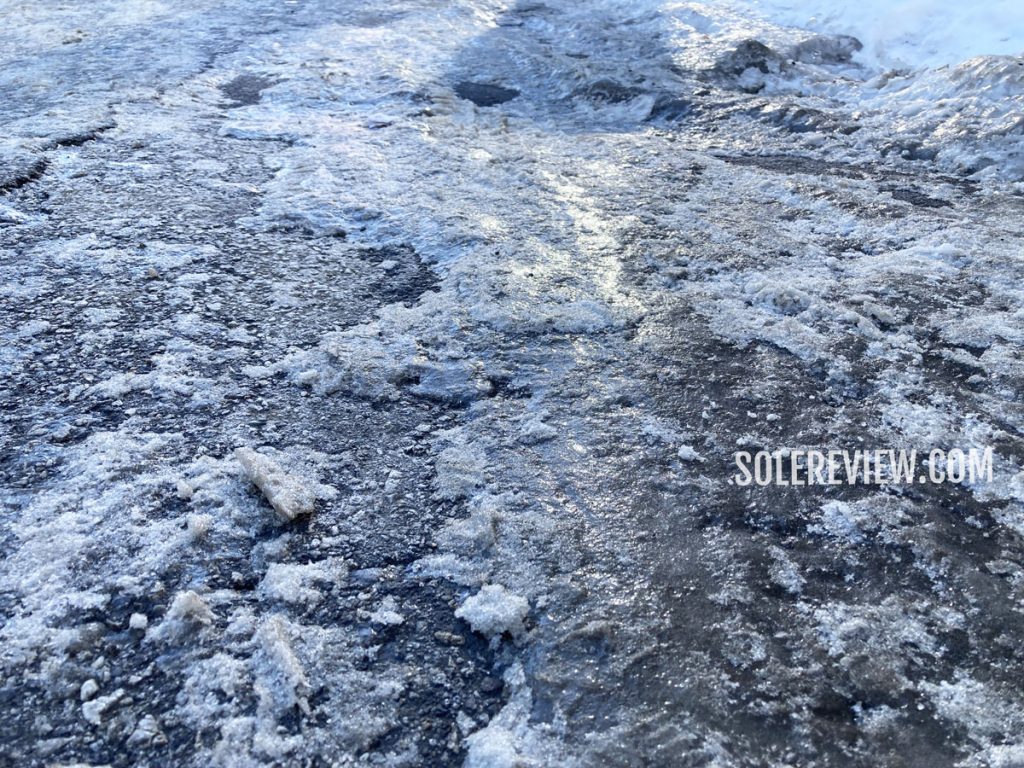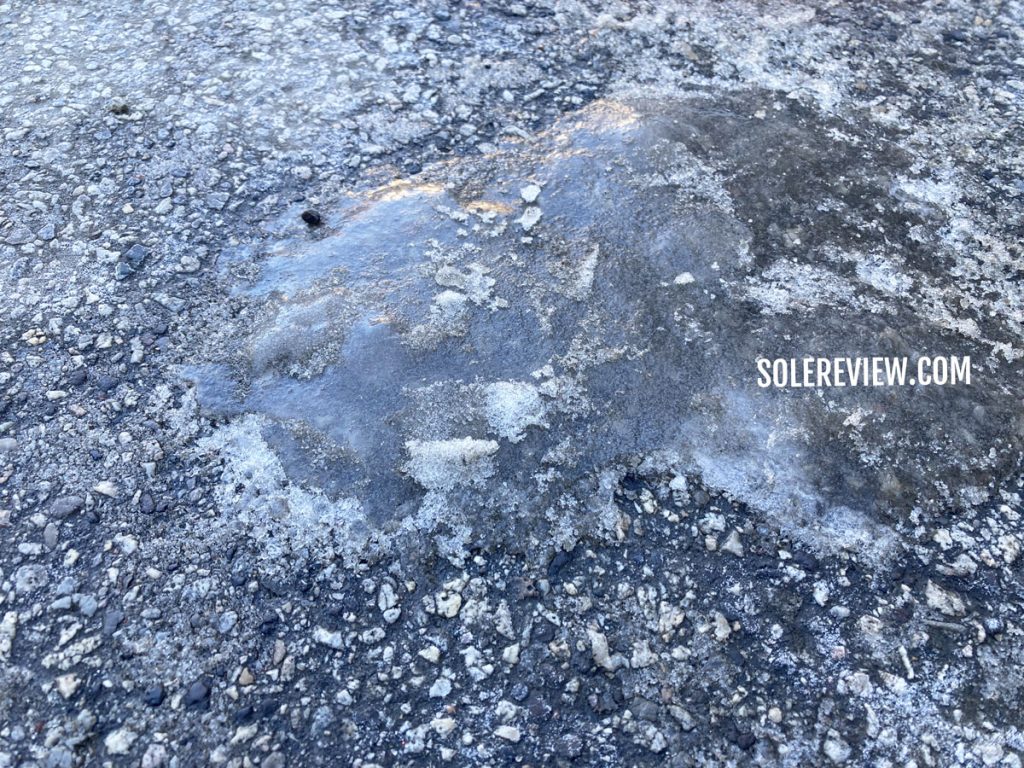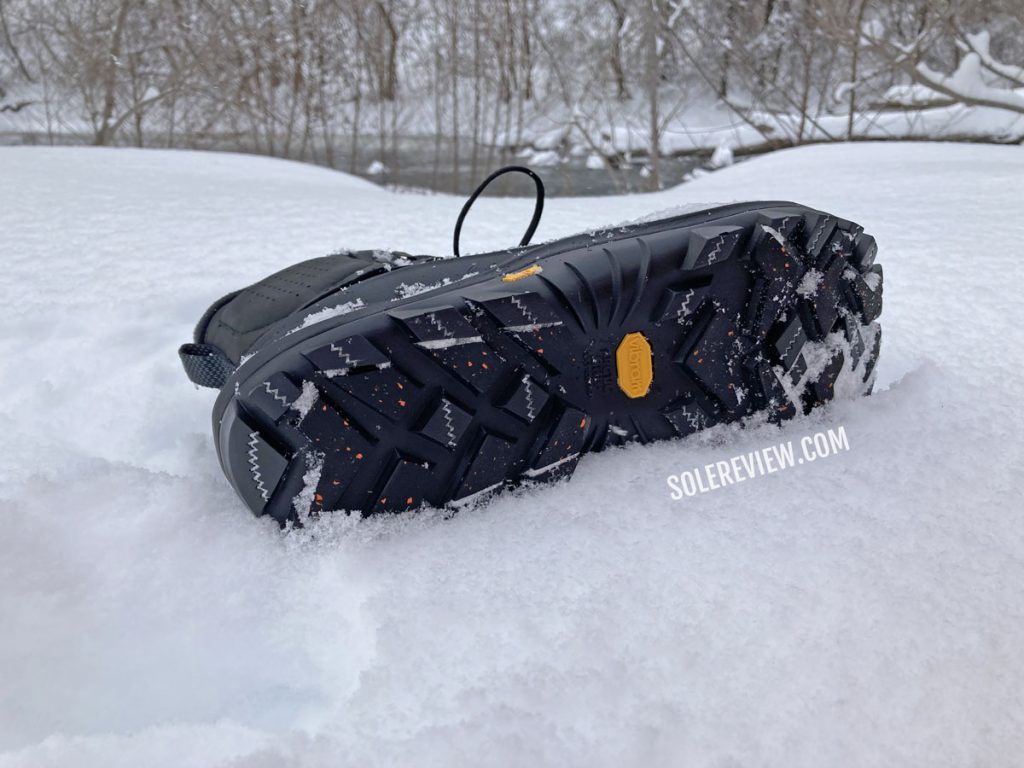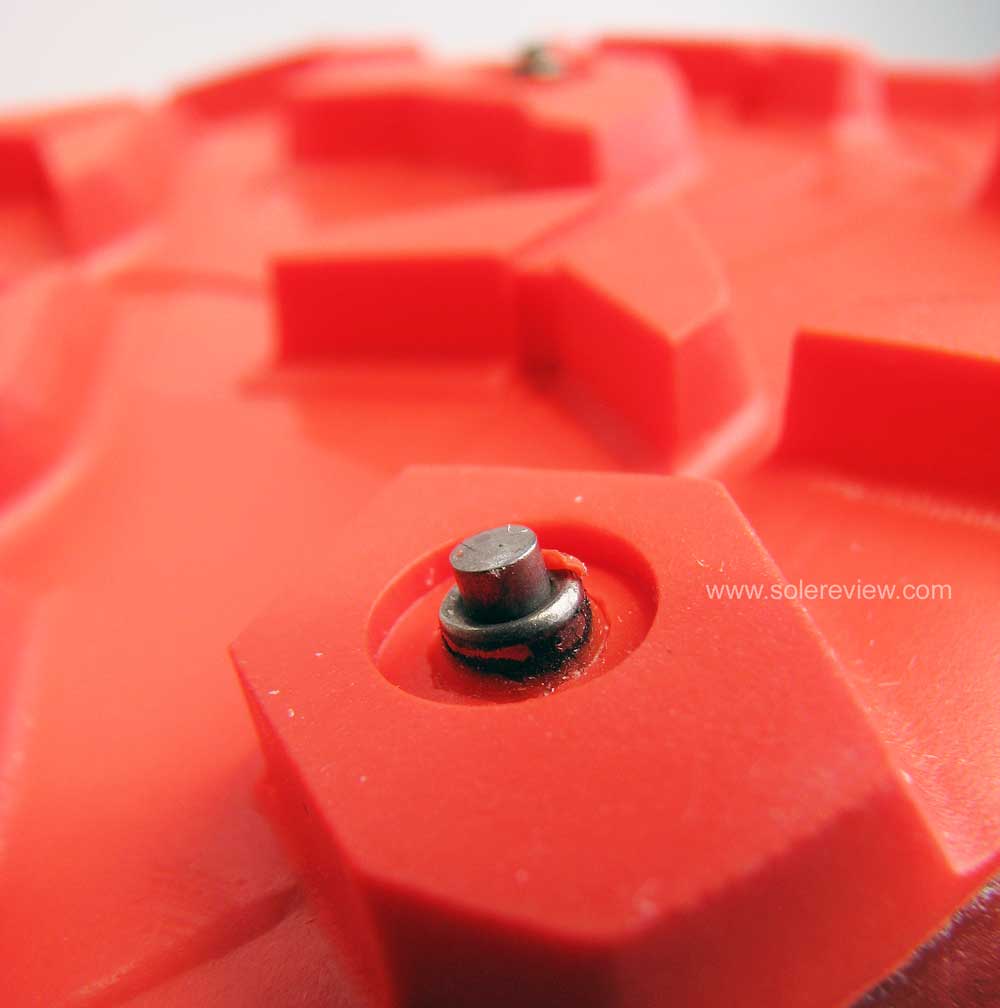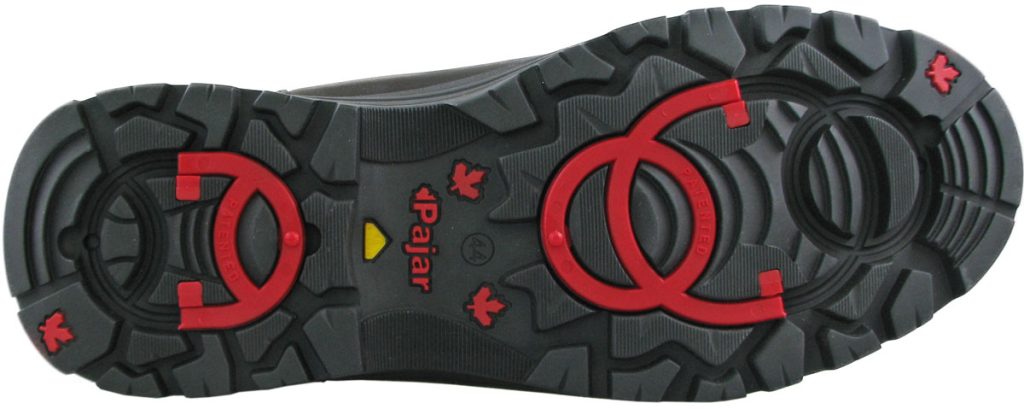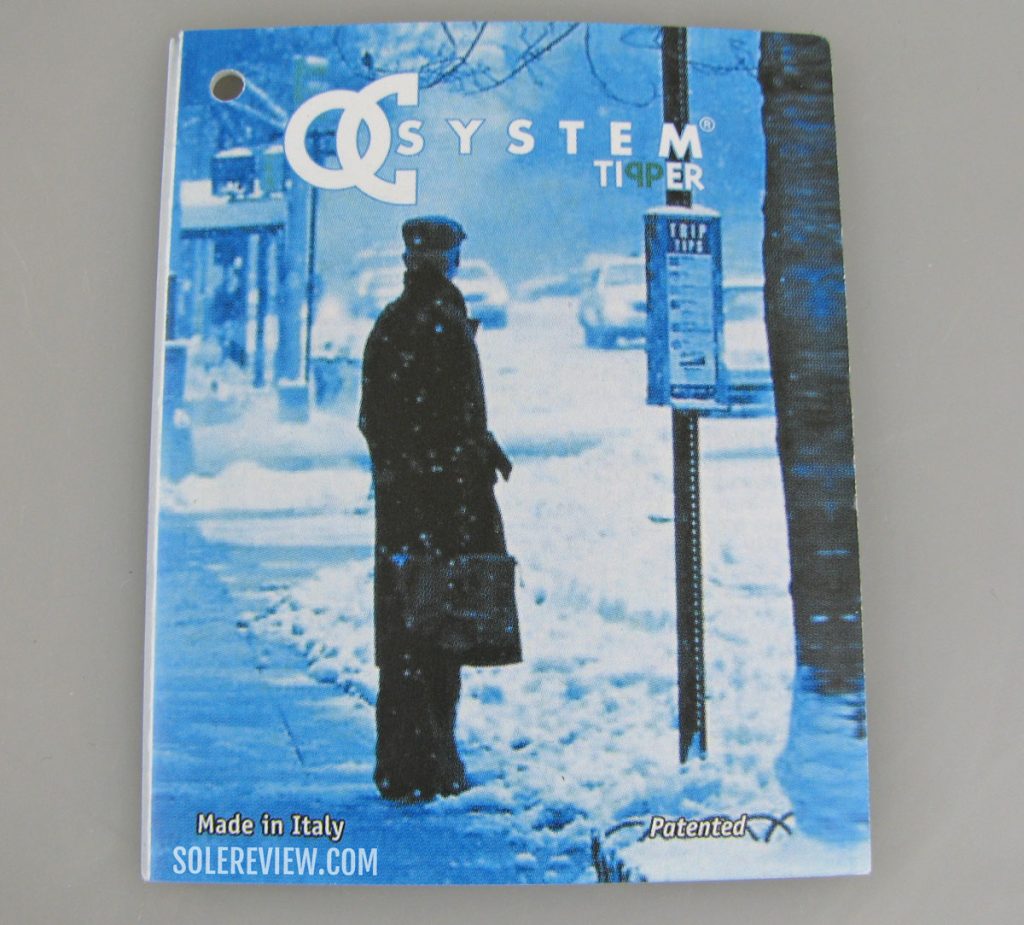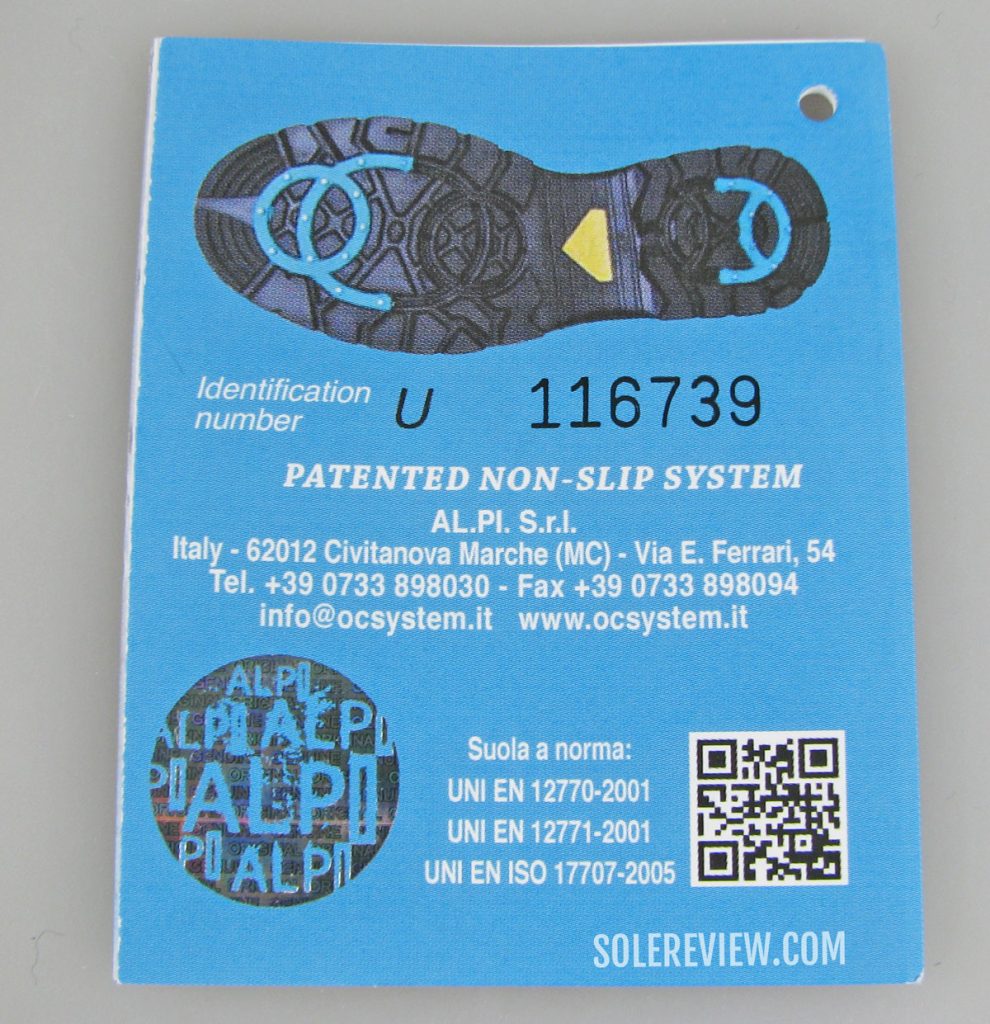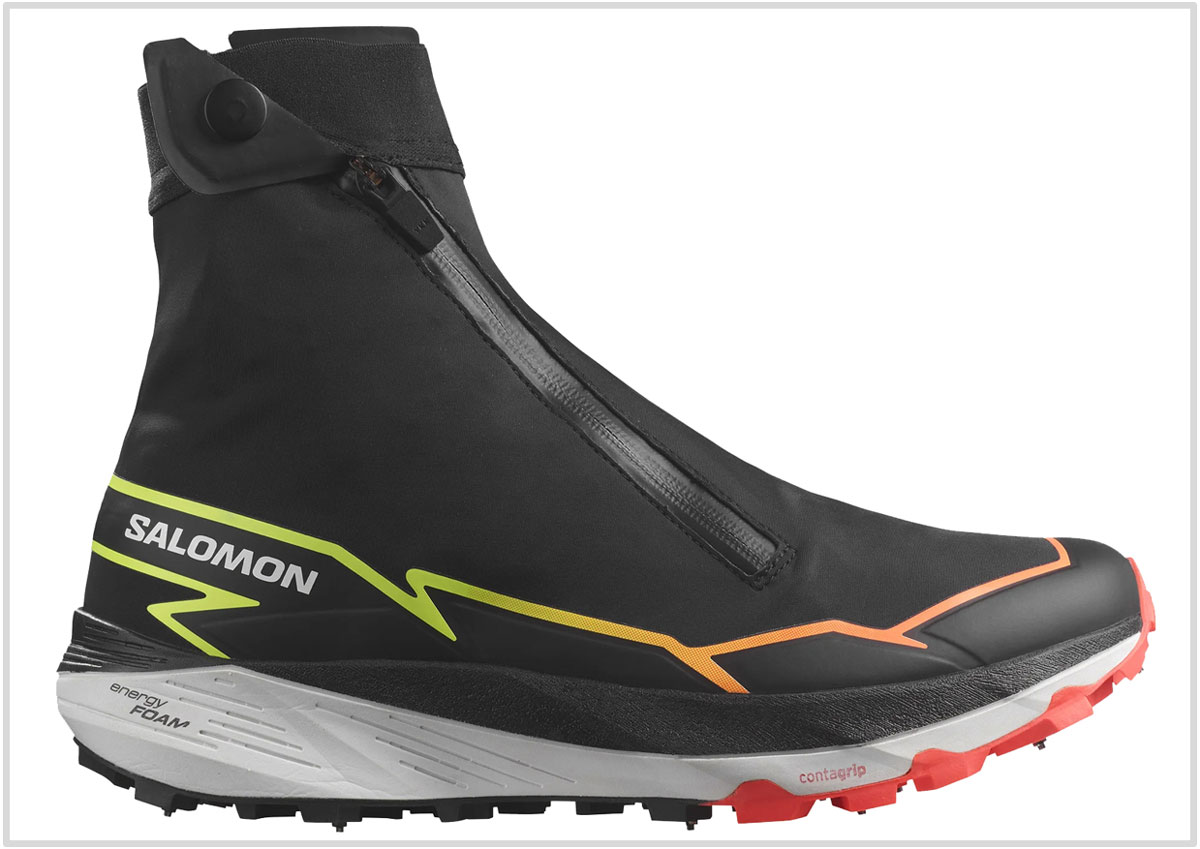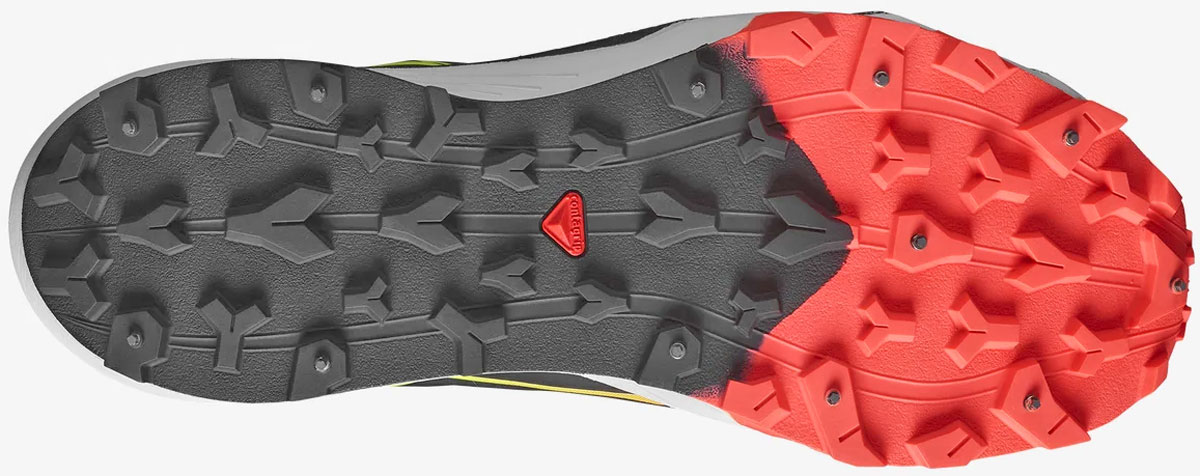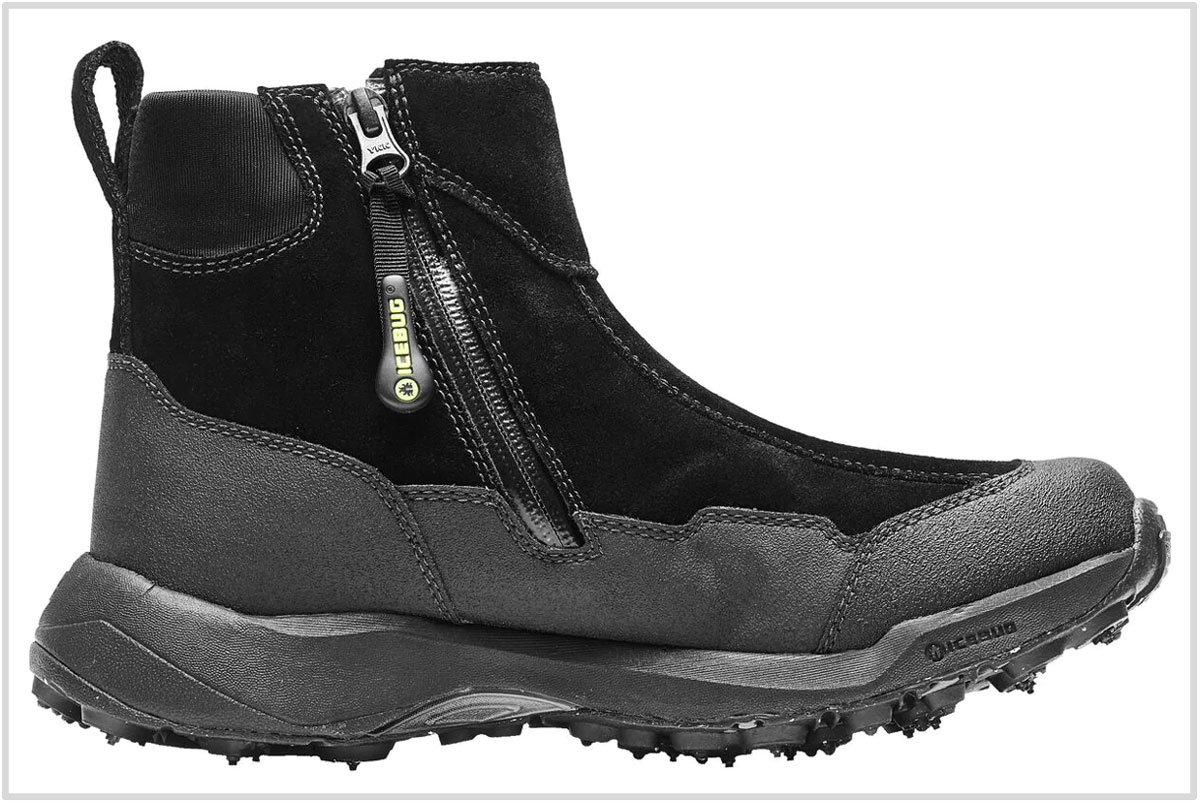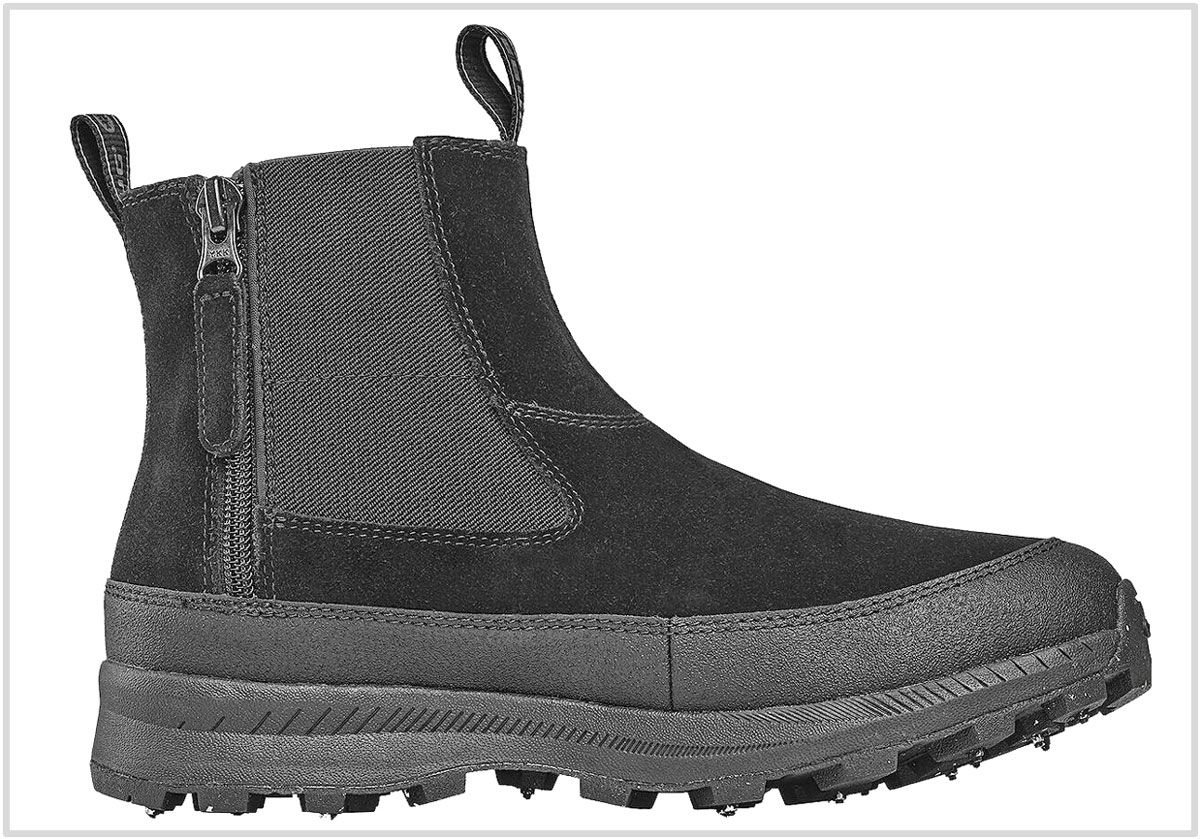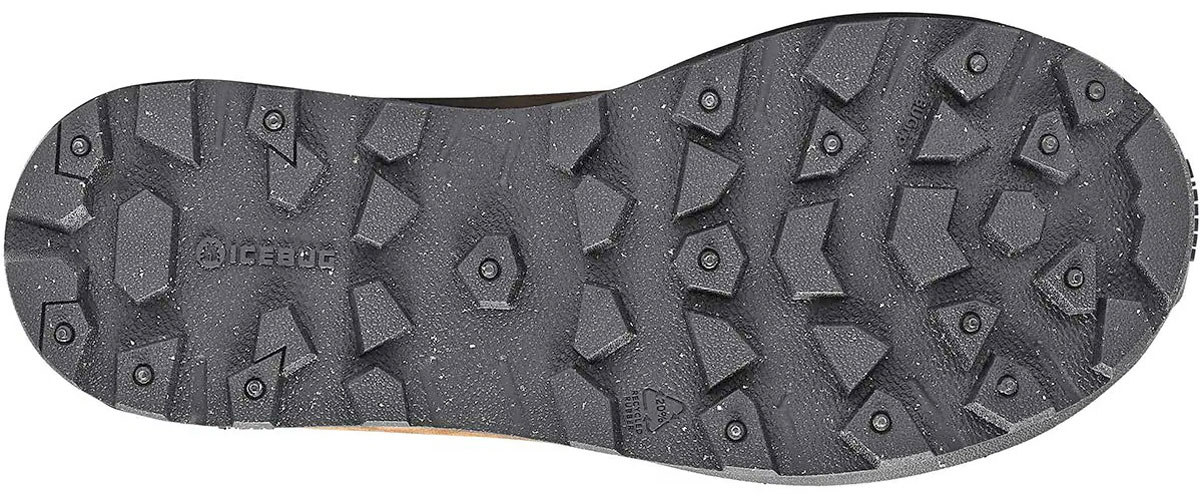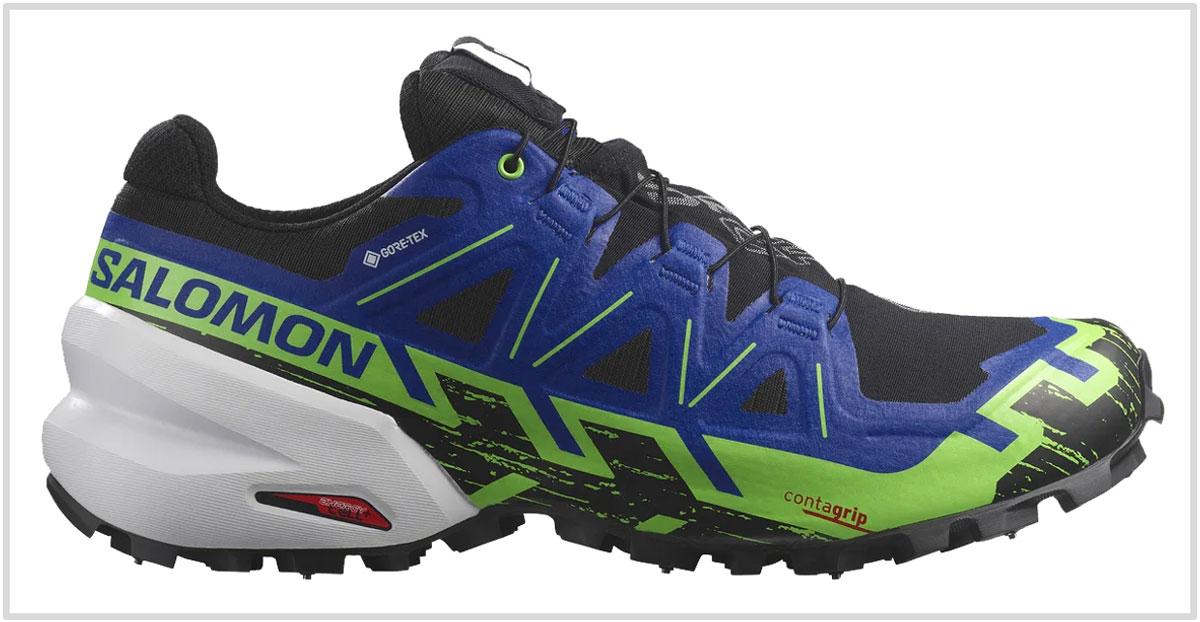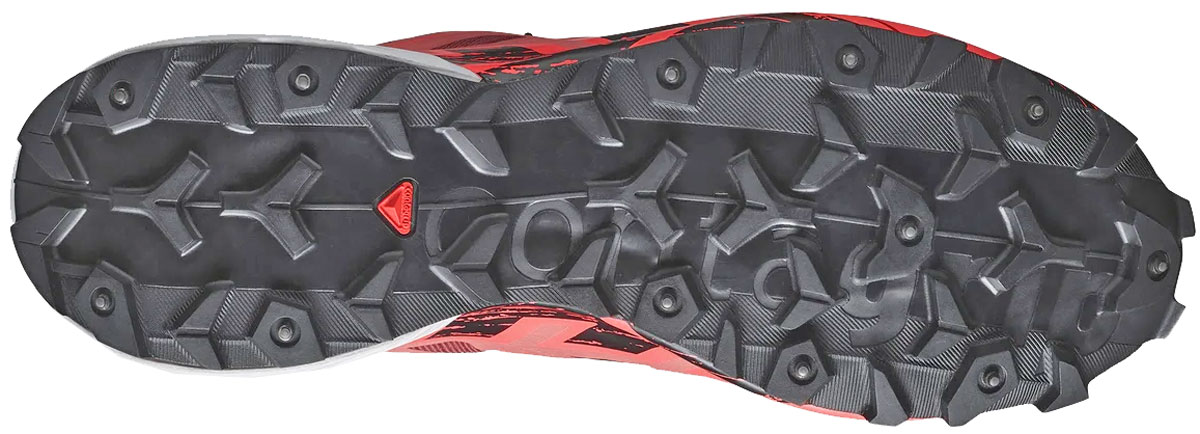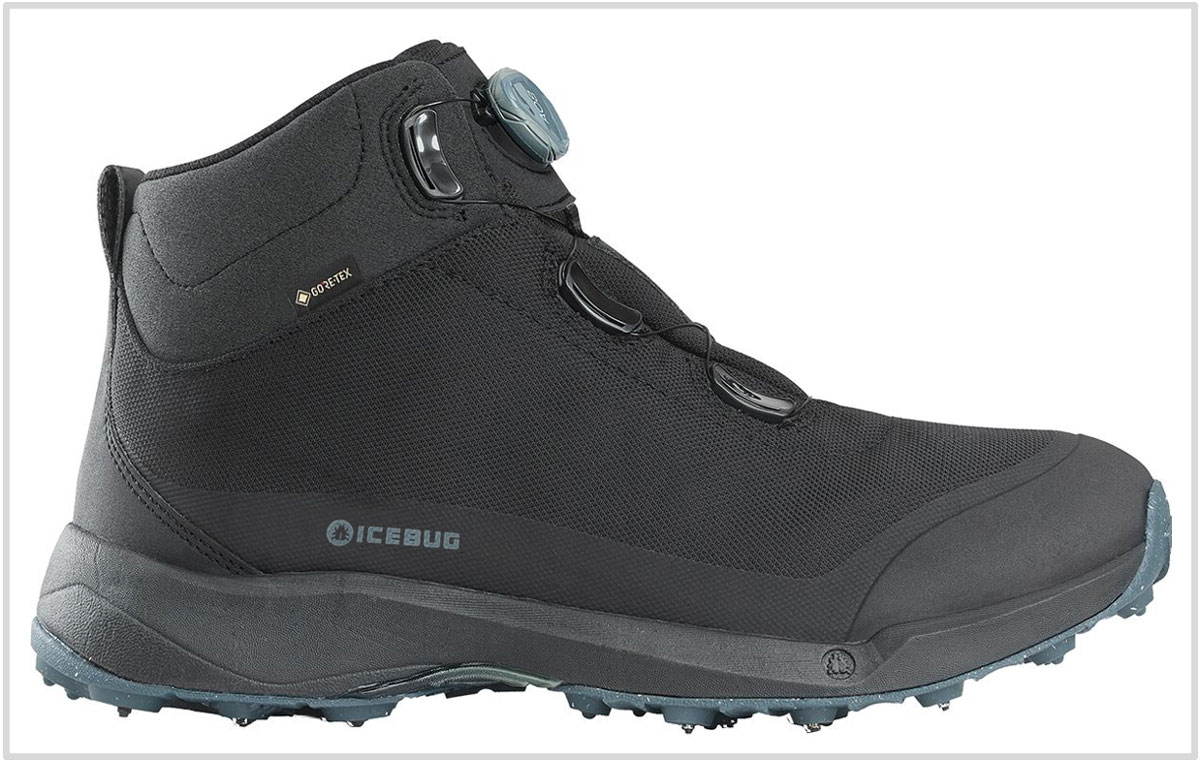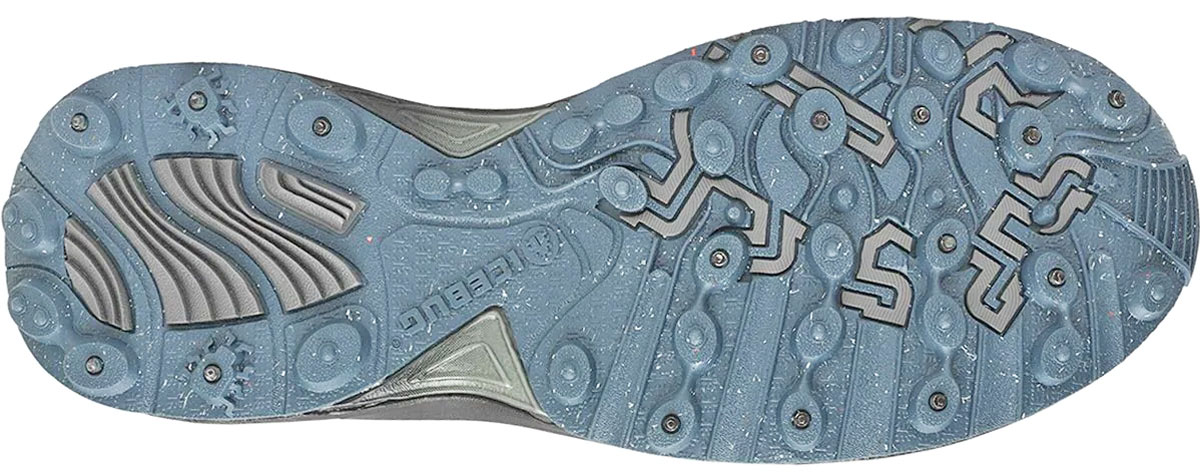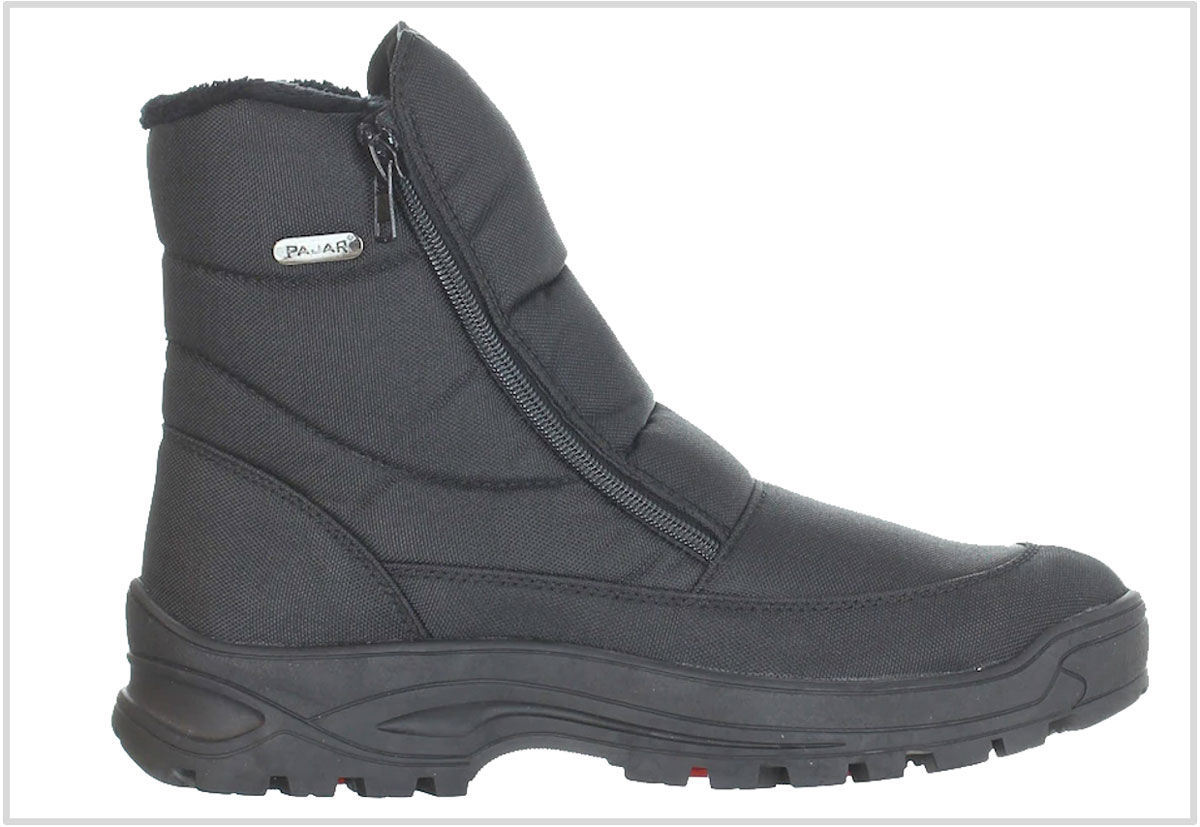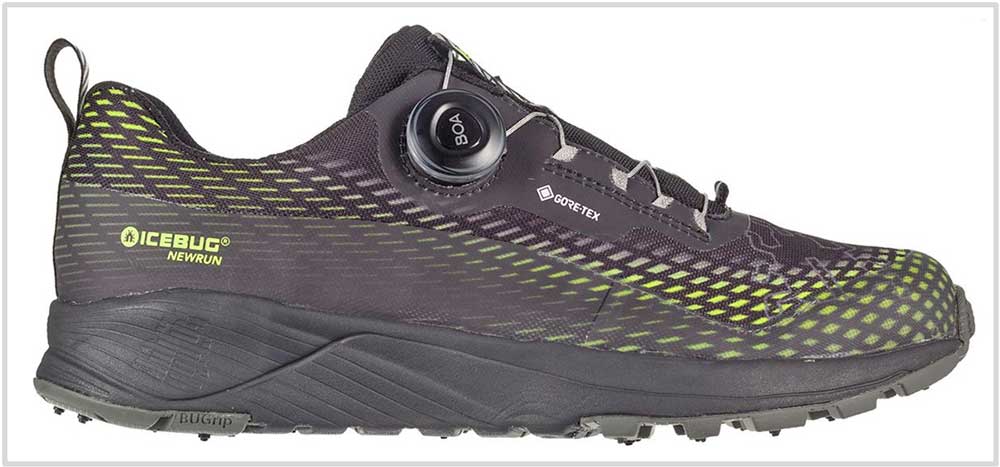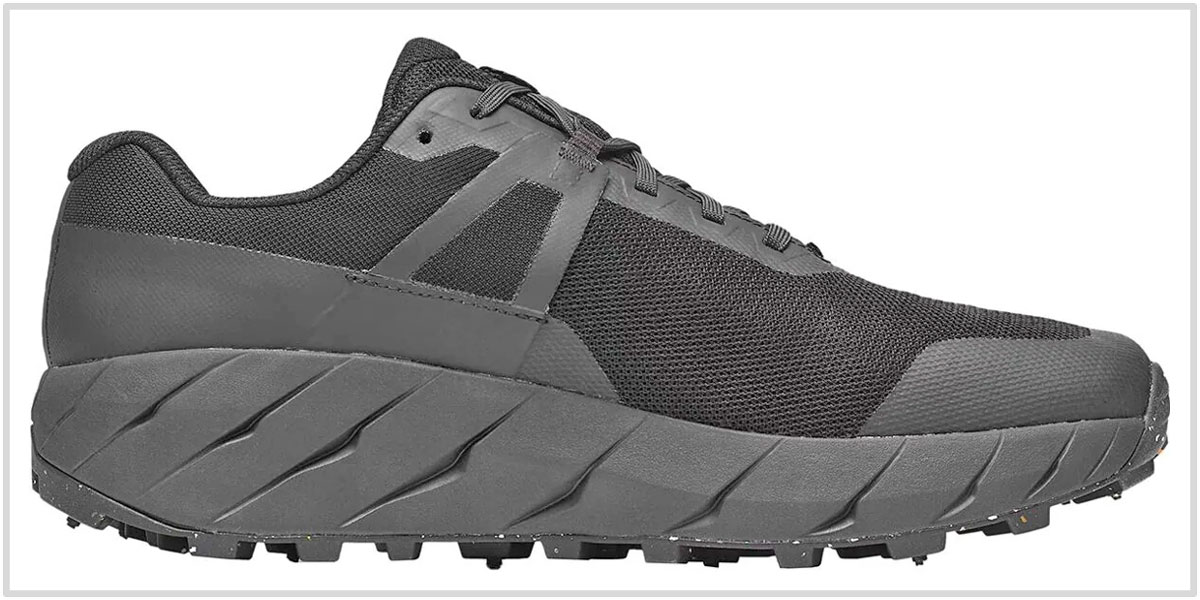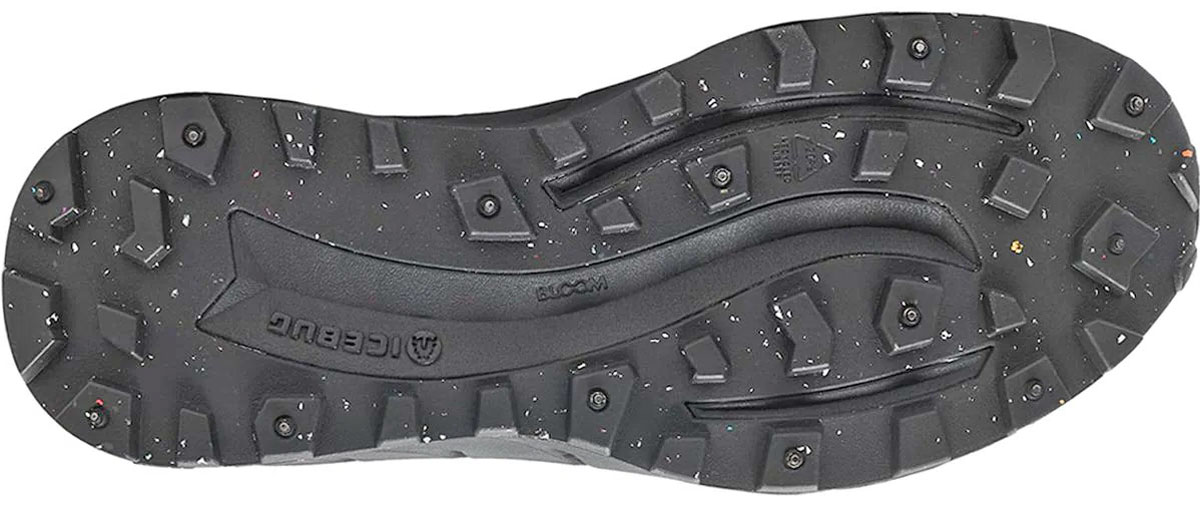This article has been updated with current models for November 2023. Most of the shoes in this guide have been updated with their current versions.
In this product guide:
- 1. What kind of shoe is good on ice?
- 2. Waterproof boot with metal spike: Salomon Winter Cross Spike
- 3. Walking boot with metal spike: IceBug Metro 2 BUGrip
- 4. Waterproof boot with metal spike: IceBug Boda BUGrip
- 5. Waterproof shoe with metal spike: Salomon Spikecross 6 GTX
- 6. Waterproof boot with metal spike: IceBug Stavre BUGrip GTX
- 7. Waterproof boot with retractable metal spike: Pajar Icepack boot
- 8. Waterproof shoe with metal spike: Icebug Newrun BUgrip GTX
- 9. Waterproof shoe with metal spike: Icebug Arcus BUgrip GTX
Metal spikes, cleats, studs – call them what you will. Only cleats, not rubber, provide safe and non-slip traction on ice. We’ll spend some time discussing the newer rubber outsoles that claim to grip on ice, and why those are (mostly) useless in real-world conditions.
When we say ‘ice’, we refer to hardened ice (black ice included) that often forms either after a period of freezing rain or other circumstances. It’s important to make this distinction clear, because soft and slushy ice is nowhere as dangerous.
It’s very common during winters for a heavy snowfall to be followed by warmer temperatures, and then back to freezing.
When that happens, all the puddles from the snow melt turn into solid ice, sometimes overnight. The following morning, commuters in the city or walkers on a trail find their shoes to offer no traction at all. Even shoes that are supposed to be ‘non-slip’ are ineffective on slippery ice.
Many studies show that slipping and falling over frozen surfaces lead to an increased incidence of injuries during winter. This makes choosing the right shoe very important.
The basic science behind how shoe outsoles grip
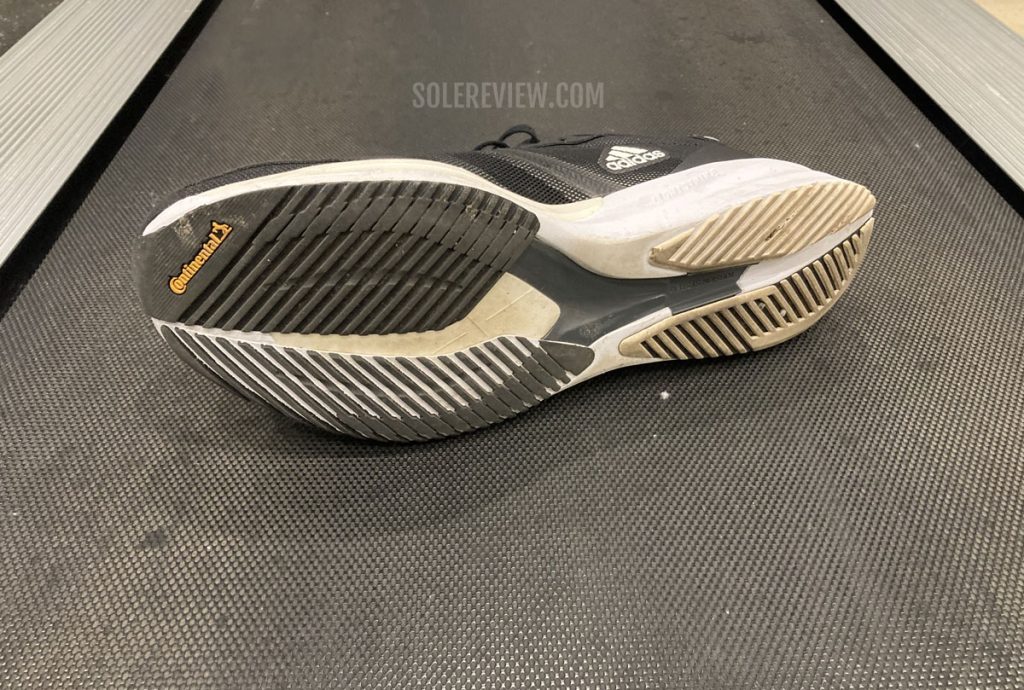
A good grip depends on the friction coefficient. Pictured here is an adidas Continental outsole over a rubber treadmill belt; that results in excellent grip due to the high friction coefficient.
The level of friction (also known as the friction coefficient) between the two opposing surfaces is what determines how well (or not) the shoe will grip.
In short, if more force is required to push a certain object over a surface, that means that the object grips better.
The opposite is also true; something that’s easy to slide over a surface has a lower grip. The overall friction depends on the material, contact area, and the force (weight) applied from the top.
Ever played Air Hockey at the local arcade? The flat puck slides effortlessly over the glossy surface when struck; a slab of Tofu or Steak will not. As you can see, the friction coefficient makes all the difference.
Winter car tires work on a similar principle. The softer winter compound doesn’t harden in the cold, thus providing the necessary levels of traction and contact area.
However, shoes don’t have the advantage that winter tires do. When walking or running on ice, there’s only a small patch of the outsole that’s in contact with the ground. And unlike a car, both feet are never in contact with the surface at the same time. And if we were to walk on all fours, that would improve the grip by a significant margin.
And that’s why it becomes necessary to ‘brute force’ the grip on ice through spikes and cleats. That’s the only reliable method of latching on to the frozen ground. While some aftermarket traction devices like the Yaktrax use coiled metal, the shoes on this guide only use spikes.
Now let’s look at some examples of surface ice.
A few examples of icy surfaces
Believe it or not, on a relative scale of ‘safe to hazardous’, the picture above is an example of a ‘safe’ surface. This pavement has been salted to lower the freezing point of water, thus preventing the formation of slippery ice. That’s why you’ll see small puddles on a salted sidewalk, even on a very cold day. Most outsoles grip well on wet sidewalks, even foam ones.
A snow-ice slush isn’t particularly dangerous if you know how to walk on it. The semi-solid surface crumbles when the weight is applied, thus providing adequate surface area for outsoles.
Here, most rubber soles (like the ones on Blundstone boots) grip well, as long as the outsole isn’t completely smooth.
Now, we’re getting into slip-and-fall territories. Flat, hardened road ice is akin to a bumpy skating rink, but with smoother ice. It gets worse on frozen slopes like icy driveways.
Here, most rubber outsoles effectively lose traction. Walking like a penguin – which is taking short steps with a fully-planted stride and lowering the center of gravity – minimizes the chances of falling.
Lastly, if we’re talking about hikes and treks on ice, then it’s crampons or nothing. For day hikes on iced-over trails that do not involve alpine climbing, short crampons with six points will do. A more aggressive crampon geometry with 8-10 points is needed for activities that involve climbing. This buyer’s guide does not address those use cases.
A brief commentary on Vibram Arctic Grip rubber and similar technologies that claim to grip well on ice
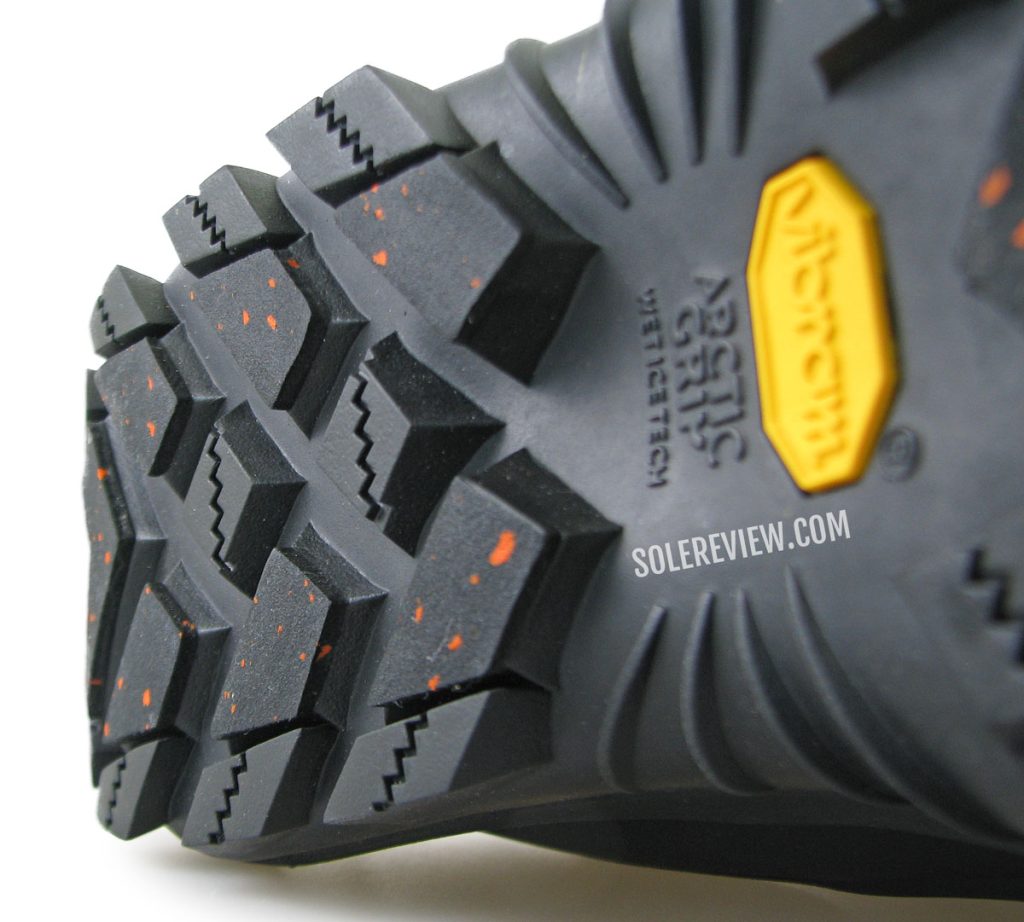
Please stay away from Vibram Arctic Grip outsoles. They will NOT provide sufficient traction on hard ice.
Here’s the lowdown. Please do not buy shoes with a Vibram Arctic Grip outsole (or similar tech) if you intend to use them on hard ice.
We’re no strangers to shoes with an Arctic Grip outsole. On this site, we have reviewed a few shoes with an Arctic Grip outsole, and our opinion hasn’t changed.
Vibram advertises its outsole as suitable for ‘wet ice’. The rough sandpaper-like texture of the rubber lugs is supposed to increase the friction between the outsole and ice to improve the grip.
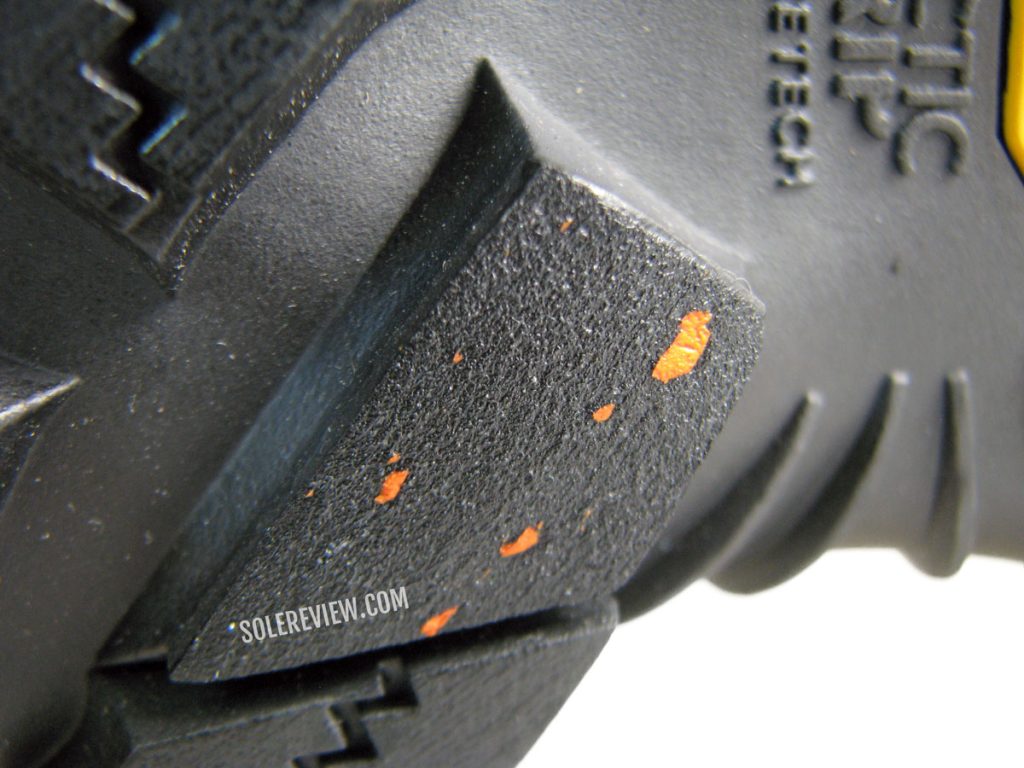
In theory, the rough texture of Vibram Arctic rubber is supposed to grip better on ‘Wet Ice’ – a surface condition that freezing winters do not have.
Now, ‘wet ice’ is not what most walkers and runners need to be worried about. They’re more likely to slip and fall on hardened ice, like the kind that we showed you.
And unlike Vibram’s marketing campaign that had people testing the outsole on a slope of wet ice with supporting handrails, there are no handrails on the slippery roads and pavements.
On these hazardous surfaces, the Vibram Arctic Ice rubber and its kind are ineffective. Brands like Keen and Dr. Martens market similar outsoles, and all of them are equally bad. They do not offer any slip resistance on black ice.
That being said, the grip of Vibram Arctic Ice on wet pavements is superlative.
Two kinds of studded outsoles for ice
Fully cleated outsoles are relatively easier to find. Salomon does an excellent job with the Spikecross, and the Swedish brand Icebug has built a vast collection of spike-tipped shoes.
Carbide-tipped steel spikes are embedded into the rubber outsole and placed under the forefoot and heel areas for traction. Our top pick here would be the Salomon WinterCross Spike – a shoe similar to the Salomon Snowspike CSWP.
Fully cleated shoes are the safest for walking on ice, and generally deliver decent levels of versatile traction on softer surfaces like slush and snow.
The biggest drawback with fixed studs is that they cannot be used indoors. Metal cleats grip very well over ice, but will slip on smooth surfaces as well as damage them.
The second group of shoes is somewhat hard to find. The outsole has retractable spikes for dual-purpose use – which means the shoes can be used on ice and indoors.
Based on our experience, only the ‘OC system’ outsole has a functional ‘on-off’ design that works as advertised.
The metal spikes are mounted on a hinged section made of TPU, and flipping the said hinge exposes them. When not needed, the spikes can be retracted into the rubber outsole. It’s an interesting design that requires a ‘key’ to switch on the spike.
The OC system isn’t without its share of drawbacks. The hinge mechanism takes up a lot of outsole real estate and makes the outsole ‘flat’ when the spikes are in a retracted position. The lack of deep lugs makes the outsole slippery on slush.
Pajar, the Canadian boot brand sells a wide assortment of boots with OC System. Naot – an Israeli shoe company – offers a couple of models as well, but Pajar does a much better job with the upper design.
Korkers also sells a few boots with an optional cleating system. However, unlike the OC system, the Korkers spike system is a separate component. So you’re better off buying standalone traction devices so that they can be used with other shoes as well. We recommend the Kahtoola Exospike – a traction system that we use regularly.
Here are our recommended shoes and boots that deliver a reliable grip on ice.
1) Salomon Winter Cross Spike
The Winter Cross Spike is the unofficial follow-up to the Salomon Snowspike CSWP – an excellent ice-friendly shoe that we reviewed a few years ago.
There are several changes, two of which concern the upper and the midsole. The midsole is no longer double-lasted (like the Speedcross) and instead uses a running shoe design. On the road (and trail), that means that the Winter Cross’s cushioning is softer than the Snowspike or even the Speedcross.
Now, here’s the real reason why the Winter Cross is recommended here. The outsole design is purposely designed for use on ice and frozen surfaces.
The Contagrip outsole is fitted with a colony of Carbide-tipped lugs for confidence-inspiring traction on icy pavements and trails alike. Besides the metal spikes, the soft rubber lug bites deep into the icy slush.
A zipped water-resistant gaiter keeps the snow and debris out; the foot is secured inside an inner shoe that’s based on the Speedcross silhouette. Do note that the upper is merely water-resistant, and not waterproof like the Snowspike CSWP.
2) IceBug Metro 2 BUGrip
The Metro 2 BUGrip is a practical everyday boot for icy commutes. Its raison d’etre is, of course, the BUGrip outsole with 16 Carbide-tipped steel studs.
Between the outsole and zipped upper are an EVA midsole and Ortholite insole for walking comfort. The upper is easy to get in and out of, thanks to the side zipper entry. While the upper is made of water-repellent suede, the synthetic guards keep the slush and mud out.
When paired with woolen socks, the fleece-lined upper is warm enough for freezing winters.
Just know that there are two versions of the Metro 2 – one with the studded outsole and another with the non-spiked Michelin rubber. Make sure to order the studded version if you’re likely to encounter ice during your walk or commute.
3) Icebug Boda Insulated walking boots
This is a proper winter Chelsea boot that keeps the insides warm till -20 C (-4F). That’s cold enough for most winters, and low enough for surface ice to harden.
That’s where the Boda boot’s 17 spikes come in handy. The metal studs vastly reduce the chances of slipping on ice.
The ride and fit comfort is delivered by the Primaloft Bio insulated suede upper over a fleece footbed and EVA midsole.
The shoe is easy to get in and out of, thanks to the zipper with a large pull tab. The pull tab also allows the shoe to be operated with gloved hands.
4) Salomon Spikecross 6 GTX
The Salomon Spikecross 6 GTX is the cleated version of the Speedcross 6, so it’s the same shoe but minus the metal spikes. Like the regular Speedcross 6 GTX, the upper uses a Gore-Tex waterproof membrane to keep the feet dry.
The Spikecross 6’s dozen Tungsten Carbide spikes over the grippy Contagrip rubber outsole make it ideal even for severe winter surface conditions.
The upper is borrowed from the Speedcross trail running shoe line-up, so it offers similar benefits. The cord lacing is easy to use even with gloved hands, and the layered upper keeps the slush out. The Speedcross upper uses a ‘double-lasted’ design for an extremely secure fit experience.
Runners who are familiar with the road-based Speedcross 6 will find little to no difference in how the Spikecross rides. The midsole is as firm as it gets, and that makes the Spikecross very stable on uneven terrain.
5) IceBug Stavre BUGrip GTX
If your idea of a winter walk involves icy trails, the IceBug Stavre BUGrip is a better choice than the Metro 2 and Boda. Even though all three IceBug models share the same studded outsoles, the Stavre’s upper has a few things that the Metro and Boda do not have.
The upper has a waterproof Gore-Tex membrane and a BOA lacing system. The BOA dial creates a more secure fit on hiking trails than urban boots, and the shoe can be fastened even with gloved hands.
The synthetic mesh and thinner mudguards also make the upper conforming and comfortable.
The Ortholite insole and compression-molded EVA midsole make the midsole comfortable enough for day hikes.
Note: There are two variants of the Stavre – one with the studded sole (BUGrip) and another without. (Michelin rubber)
6) Pajar Icepack boot
On paper, the Pajar Icepack boot is rated up to -25 C (-13F). Realistically, we think it will survive -15 C (5F) even when stationary. And if you’ve ever lived in a cold country, you’d know that there is a huge difference between walking and standing in freezing temperatures.
The Pajar Carson boot has a waterproof nylon upper with an insulated wool-blend lining. Even the removable insole uses wool-blended fleece, so the insides are extremely warm and comfortable.
The fit is large and sloppy, so we highly recommend trying them before buying, if that’s possible.
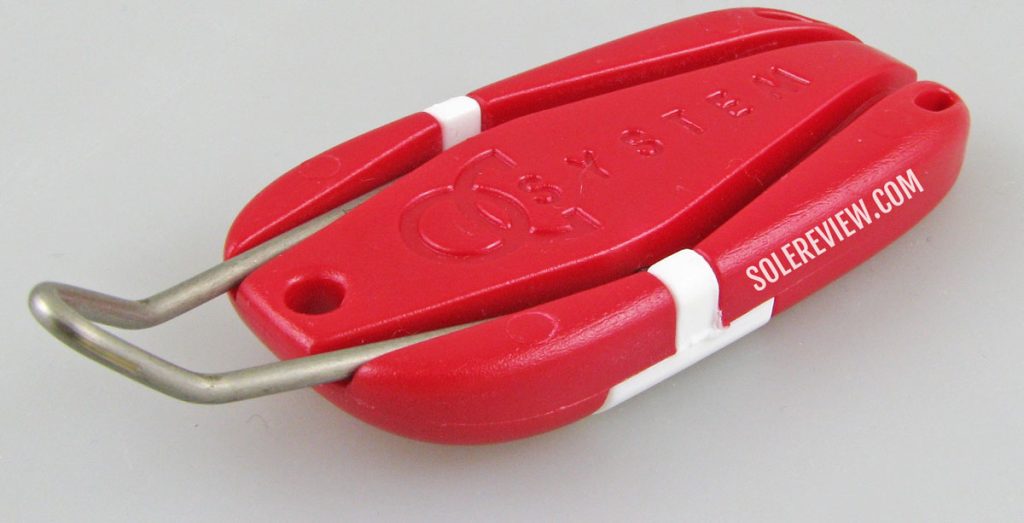
This pocket tool is supplied with every Pajar product that has an OC system outsole. The curved loop helps flip the outsole hinge to activate the spikes or retract them.
The rubber outsole has OC System’s patented ice-gripping system. Admittedly, finding the ’slot’ for the provided metal key takes a while to get used to. Other than that, the changeovers are way easier than retrofitting a traction device.
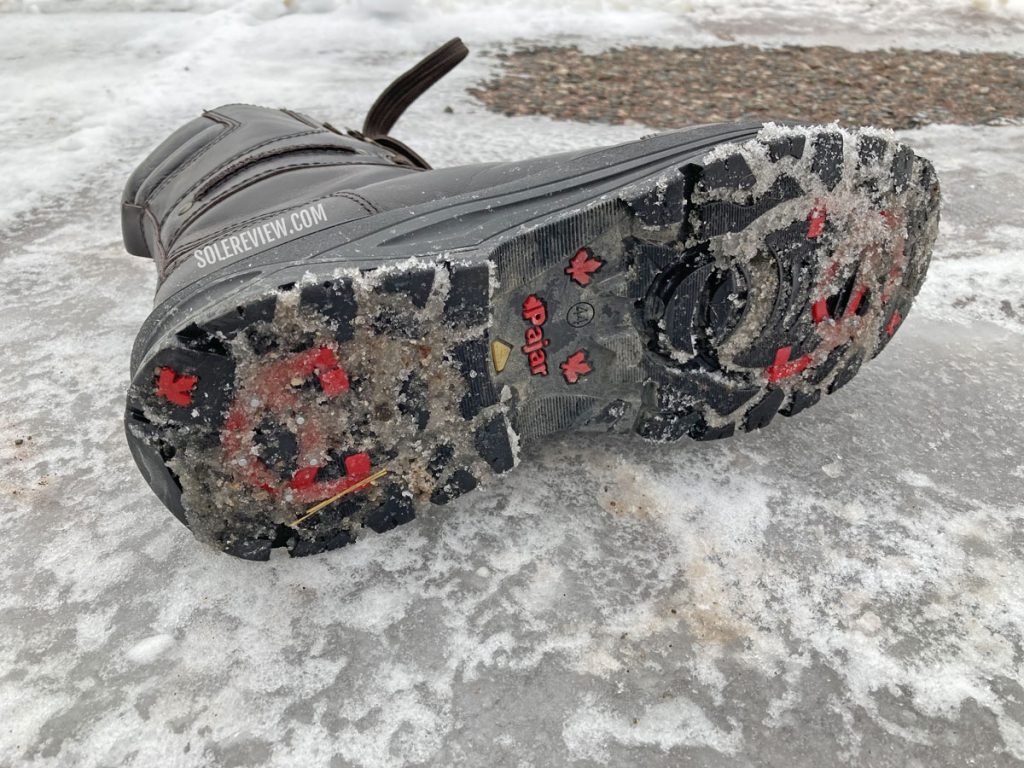
The cleats aren’t mounted on the rubber lugs, so their short length is a limiting factor on slush or snow-covered surfaces.
Just remember to flip the outsole back to the non-cleated position when going indoors. On the ‘flip’ side, the outsole traction is poor on softer surfaces like slush and snow due to the flat outsole geometry.
While not the exact model, our detailed review of the Pajar Carson boot explains the Ice-gripper’s benefits and shortcomings.
7) Icebug NewRun BUGrip Gore-Tex
The NewRun BUGrip is not winterized or insulated, but has a waterproof closed mesh upper. With the right pair of running socks, the Icebug will work as a winter running shoe for up to -5 C ( 23F) or even slightly colder. The fused synthetic cladding also blocks the wind and moisture.
The Newrun’s outsole is generously spiked – a total of 17 Carbide-tipped studs offer a reassuring grip on ice-covered roads and sidewalks.
An EVA foam midsole and Ortholite insole provide the ride comfort that’s expected of a performance running shoe.
8) Icebug Arcus BUGrip Gore-Tex
The Arcus BUGrip is somewhat similar to the NewRun, except for two major differences. The upper uses a conventional lace closure rather than the BOA dial used on the NewRun.
Secondly, the thicker midsole provides a higher level of cushioning. There are other minor differences like the wider toe-box and fewer studs on the outsole.
The Arcus’s outsole has 13 Carbide-tipped studs for confidence-inspired traction on icy roads and trails. Over the cushioned midsole is an Ortholite insole, so the ride comfort is comparable to a performance running shoe.
The upper is non-insulated, but uses a closed mesh upper that’s also waterproof due to the Gore-Tex membrane. When used with wool running socks, the Arcus will work as a winter running shoe for up to -5 C ( 23F) temperatures.

